The strange death of Lord Kitchener

Simply sign up to the Life & Arts myFT Digest -- delivered directly to your inbox.
On a sunny day, Marwick Head is a glorious place to be. Sandstone cliffs tumble sheer into peacock and petrol-blue water. Fulmars, kittiwakes, guillemots and puffins swirl over the sea below, and the rock faces are a cacophony of screams and whoops from the nesting gulls. The clifftop air is rank with the fishy stink of uncountable quantities of guano.
At the top of the headland stands a squat, crenellated tower. Almost 50ft high and visible for miles, it has no obvious function – too fat to be a lighthouse, too small to be a castle. A stone panel on the landward side explains: “This tower was raised by the people of Orkney in memory of Field Marshall Earl Kitchener of Khartoum on that corner of his country which he had served so faithfully nearest to the place where he died on duty. He and his staff perished along with the officers and nearly all the men of HMS Hampshire on 5th June, 1916.”
Though it is hardly remembered at all today, the wreck of the Hampshire was seen at the time as little short of a national disaster. Hundreds of men perished that night, among them the best-known soldier in the English-speaking world, who, in June 1916, became the most senior officer from either side in the first world war to die on active service.
Horatio Herbert Kitchener embodied the British war effort, and his now-forgotten death is a salutary tale about the fate of heroes.
. . .
When news of the loss of HMS Hampshire reached London, Sir Arthur Conan Doyle reached for his purple inkpot. Lord Kitchener, he said, had left behind “the memory of something vast and elemental, coming suddenly and going strangely, a mighty spirit leaving great traces of its earthly passage.” How to register the loss of this powerful force? Prime Minister Herbert Asquith asked parliament to petition the king for the construction of a national memorial to commemorate Lord Kitchener. Though a bronze statue was erected on Horse Guards Parade, no great national monument was ever built. The worthies responsible settled instead on dedicating one of the chapels in St Paul’s to his memory – “K” shares the place with everyone else who died in the war – and a grant to the medical school at the University of Khartoum, the city he had subjugated for the empire. With the coming of peace, “Kitchener scholarships” became available to surviving soldiers who had had their education disrupted by war service. Hearing of his death, half-a-dozen local communities inscribed K’s name on to the memorials they were already building to their own dead, alongside the names of ordinary soldiers and sailors who had answered his 1914 appeal for volunteers and would never return.
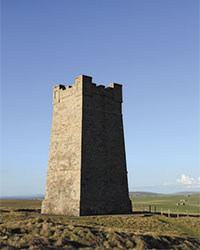
But the people of Twatt wanted something grander. No records of their discussions survive, so quite why the inhabitants of this tiny Orkney village were overcome by the urge to raise a great tower to commemorate Lord Kitchener in that summer of 1916 is a matter of conjecture. As far as we know, he only visited the Orkneys in order to change ship, which means he can hardly have known the place at all.
Maybe it was an understandable sense that since he had drowned a mile or so off their coast, he was theirs. The feeling was strongly held enough for the islanders to raise over £700 (perhaps £28,000 at today’s values) to build a memorial in local stone. The drowning had hit them hard. “It is a national calamity. There was only one Kitchener and no one can take his place,” lamented a 70-year-old woman in a letter from the village of Skaill, sharing in a feeling which swept the whole country. But Orkney was especially affected, she thought: “Dead bodies are being washed up on the shore. There were 4 or 5 found last Wednesday evening [and] another one was found off the Hole of Rowe. All this is most distressing to us.”
. . .
When the shots rang out in Sarajevo in 1914, Britain had been without a war secretary, the previous occupant having been forced to resign earlier that year. The 64-year-old imperial paladin, Horatio Herbert Kitchener, was a soldier rather than a politician, yet the obvious choice for the job. He was immediately summoned to Downing Street to receive his appointment. At 6ft 2in, with piercing blue eyes set in a face weathered by years of overseas soldiering, he was an imposing presence. “If not a great man, he was, at least, a great poster,” the prime minister’s wife, Margot Asquith, was supposed to have sneered, referring to the famous recruiting advertisement. But the man brought the same ruthless drive to running the war effort as had characterised his imperial war-making and without his appeal for volunteers, Britain could not have survived the early stages of the fighting. He soon became to the first world war what Winston Churchill would later be to the second world war.
This vain, imposing, arrogant man arrived at the War Office in 1914 garlanded with medals, stars and satin sashes awarded for raising the Union Jack over numerous corners of foreign fields. Having survived a brutal and eccentric upbringing in Ireland (his father disdained blankets, preferring to sleep under sheets of newspaper sewn together, and once punished his son by staking him out on the lawn, wrists and ankles tied to croquet hoops), he had risen to become not merely a general but the greatest public expression of ramrod uprightness. He had subjugated not just his fear but his physical comfort to the Manifest Destiny of the greatest power on earth. He had never married.
By the time of his appointment as war secretary, Kitchener had already served as consul-general in Egypt and commanded the army in India. Most famously, he was “the Sudan machine”, the man who had crushed the massive force of Islamists which had risen in the desert against the British empire and beheaded another imperial hero, the romantic, half-mad General Charles Gordon of Khartoum. After a retaliatory campaign in 1898 (more slaughter than combat), Kitchener had led his punitive expedition into Omdurman riding on a white charger surrounded by kilted Highlanders. There he set up his machine guns on the plain and mowed down 11,000 spear-carrying “dervishes” in their long, patched smocks, for the loss of a mere 48 officers and men. Soon, his moustache was the personification of empire, emblazoned on biscuit tins, buttons and postcards.
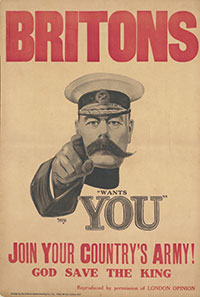
So, even though he had several times said that he would rather sweep the streets than have a job in the War Office, when war broke out in 1914, K was immediately appointed war secretary. The Times reflected the popular mood, writing: “We need hardly say with what profound satisfaction and relief we hear of Lord Kitchener’s appointment.” The new war secretary was no bonehead and quickly delivered himself of the hugely significant judgment that, far from being over by Christmas, the fighting would last for years. He recognised at once that Britain’s small professional army – vastly outnumbered by the conscript forces of continental Europe – would need to be multiplied in size many times. The war would be won, he said, by “the last million men”.
The Cabinet table was an odd place for a man who despised politicians. And by 1916, many of them were coming to despise him, too. Thousands of lives had been lost in the doomed Gallipoli adventure, and Kitchener carried the can, too, for a calamitous cock-up in the supply of artillery shells in the spring of 1915. In a true pots-and-kettles observation, the new minister of munitions, David Lloyd George, castigated his managerial style by likening Kitchener to “one of those revolving lighthouses which radiates momentary gleams of revealing light far out into the surrounding gloom and then suddenly relapses into complete darkness”. Two years into the war, Prime Minister Herbert Asquith felt able to reduce Kitchener’s responsibilities but dared not cast him completely aside. A motion in the House of Commons in May 1916 sought to reduce his salary by £100, a signal of loss of confidence which the war secretary undermined two days later by appearing before a committee of MPs in his field-marshal’s dark-blue undress uniform: his apparent frankness and his colossal reputation won them round. The electorate loved him and the politicians knew it.
But then came an opportunity to get the man out of the way, for a little while at least.
. . .
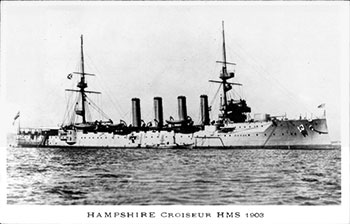
Say what you like about the Kaiser, he was good for Orkney, the windswept, sparsely populated islands north of the Scottish mainland. When the German navy threatened Britain, the Orkneys’ huge, protected bay at Scapa Flow provided a vast natural refuge for much of the Royal Navy’s Grand Fleet. This was Kitchener’s destination when, on June 4 1916, he boarded a night train at King’s Cross station in London for the 700-mile journey north to the most northerly town on the British mainland, Thurso. The following morning he crossed to the Scapa anchorage. Here he boarded the armoured cruiser HMS Hampshire to embark upon a secret voyage to Archangel, for talks with Britain’s Russian allies. The tsar was begging for fresh supplies of guns and explosives and Britain was worried whether Russia, which had taken enormous casualties, would have the will to stay the course of the war. Kitchener jumped at the idea of leading a mission of reassurance. As the commander of the Grand Fleet, Admiral John Jellicoe, recalled later, the war secretary “expressed delight at getting away for a time from the responsibilities and cares attaching to his Office”: he seemed almost to think of his mission as something of a holiday.
Within hours of embarking on his sea voyage, Kitchener had vanished.
. . .
The captain of the ship carrying the war secretary and his dozen-strong staff – translator, policeman and staff officers – was ordered not to follow the obvious route to northern Russia. Instead of steaming directly out into the North Sea, following the sea lanes regularly patrolled by mine-sweeping vessels, the Hampshire was to sail into the Pentland Firth, then to turn north, hugging the western coast of the Orkneys and only to head for Russia once it had passed to the north of the islands.
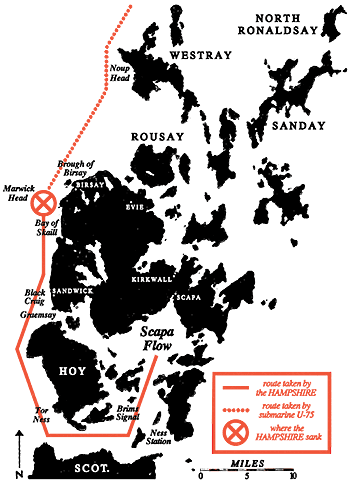
There was certainly a reasonable argument for the unusual course, for by early afternoon a fierce storm was blowing from the northeast and the lee of the islands offered some shelter. Even though the sea was far too rough to launch a torpedo, the Hampshire was instructed to maintain a speed of 18 knots to outrun any U-boats which might be lurking in the area. That afternoon the storm changed direction, anyway, and was soon blowing into the face of the warships. Nonetheless, Herbert Savill, the captain of the Hampshire, attempted to keep to the ordered speed and had soon outpaced the two destroyers assigned as escort vessels: looking back through his binoculars the captain could catch only occasional glimpses of them in the mountainous seas and by 7pm he had sent them back to base. Flashing a final “good luck” message, the escorts returned to Scapa.
Less than an hour later there was a tremendous explosion. The Hampshire shuddered and took on water. “It was as though an express train crashed into us,” recalled a stoker who survived. The lights on the cruiser failed as the electrical system short-circuited, though the propellers continued to turn. Within minutes, the vessel was sinking by the bows, with most of the lifeboats unlaunchable in the storm. It was still daylight, and onshore in the Orkneys observers from the Royal Garrison Artillery had seen the Hampshire explode. The postmistress in the remote settlement of Birsay sent an immediate SOS by telegraph to Kirkwall to alert the naval authorities. But the Hampshire went down in 15 minutes – time only to launch three small life rafts, which were soon hopelessly overcrowded with desperate sailors. Interviews in the local archives hold the recollections of some of the Orcadians who braved the howling winds and torrential rain to try to rescue those sailors who might make it to the few inlets between the cliffs. They found the life rafts dashed on the rocks, one thrust by the enormous waves into a crevice in the cliffs high above the sea. The official report lists 643 dead, though local historian Brian Budge believes the true figure to be 725. It is certain that there were a mere 12 survivors. Of Lord Kitchener there was no sign at all. Though corpses continued to wash up the shores of the Orkneys for weeks afterwards, K’s body was never found.
Two of the survivors later testified to an Admiralty inquiry that as the ship sank, the war secretary emerged from the gun room, when there was a call of “Make Way for Lord Kitchener!” to allow him passage through the frightened men pouring up to reach the lifeboat stations. The British war secretary was last seen standing in his field marshal’s uniform on the starboard side of the quarterdeck, calmly talking to two staff officers as the ship went down.
Only two days before Kitchener’s departure from London, the British Grand Fleet had scurried back to Scapa Flow after the battle of Jutland, to discharge casualties, refuel and repair. The biggest naval engagement of the whole war had certainly not been the victory which the world’s greatest fleet – and the British public – had been encouraged to expect. On a straight actuarial assessment, the Royal Navy had lost more ships (14 vessels and more than 6,000 lives) than the Germans (11 ships and more than 2,500 casualties). The Germans swiftly proclaimed they had won a great triumph. As the commander of the High Seas Fleet, Admiral Reinhard Scheer drank champagne, a celebratory public holiday was declared and the Kaiser boasted to his sailors that, “The spell of Trafalgar has been broken. You have started a new chapter in world history.”
On this occasion, triumph lay with he who proclaimed it first and most noisily. The British government stumbled about, issuing contradictory assessments, always too late and none of them proclaiming victory. Watching one British battlecruiser after another explode, Admiral David Beatty had declared, “There seems to be something wrong with our bloody ships today.” There was much blaming of the unhelpful weather.
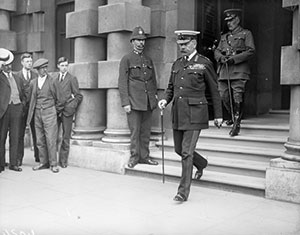
Then, within days of one disaster came another. Dark-suited men clustered around the noticeboards of the gentlemen’s clubs of St James’s, where the terse communiqué from the commander-in-chief of the Grand Fleet had been cut from the newspapers and pinned, those at the back of the huddle asking in hushed voices, “Is it true?” The king noted his personal distress at the news of Kitchener’s death in his diary: “It is indeed a heavy blow to me & a great loss to the Nation & the Allies.” He ordered army officers to wear black armbands for a week. Across the nation, hands trembled as people read of the calamity in the early editions of the newspapers. The Daily Mirror distributed 1.5 million copies that day.
The conspiracy theories began almost at once. How could such an important figure, in the full protection of the greatest navy in the world, be dead? On June 7, the Evening News reported that all over London people believed the sinking had been the work of German secret agents. On hearing the shocking news of K’s death, members of the stock market cried out, “This is the work of spies! Shall we any longer tolerate German-born members in our midst?” Establishment figures like Admiral Jellicoe and First Lord of the Admiralty Arthur Balfour – to say nothing of absurd bigots like the founder of the nationalist rag John Bull, Horatio Bottomley – were inundated with letters alleging the disaster had been the work of German fifth columnists, Bolshevik infiltrators or Irish nationalist saboteurs. Sometimes – as when an officer was said to have been spotted going into K’s cabin and proffering him a service revolver, to enable him to do the decent thing – it was claimed that the disaster had been perpetrated by the British government.
Then there were the theories that Kitchener wasn’t dead at all. Why, since his sister had been unable to make contact with him through a medium, he must be alive! He was in Russia, commanding the tsar’s army. He had been spotted living in a cave in Orkney. Like King Arthur or Barbarossa, ‘K’ would return when his country most needed him.
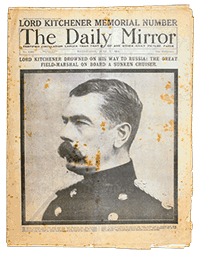
The Admiralty conducted two separate investigations, the first in the immediate aftermath of the disaster, the second a full 10 years later. Each of them concluded that the ship must have hit a German mine. On June 22 1916, Sir Richard Cooper MP demanded to know “on what evidence the Lords of the Admiralty formed the conclusion that the Hampshire struck a mine”. Six months later he was still, unsuccessfully, demanding answers: British officialdom’s traditional instinct for secrecy in a crisis asserted itself at once and held sway for decades. Even in 1959, Donald McCormick, a cheap journalist who had once worked alongside Ian Fleming, published The Mystery of Lord Kitchener’s Death, a self-proclaimed definitive look at various possible causes of death, rehashing selected conspiracy theories about secret agents, bombs and the rest. Refused access to Admiralty records beyond the official White Paper, he offered little that might be called evidence. The Conservative MP Irene Ward then plaintively asked in parliament whether the Admiralty might now make available the documents referring to the loss of HMS Hampshire. Four decades after the event, they said they could not.
. . .
But, in 1926, Kitchener did return. A journalist, Frank Power (real name Arthur Vectis Freeman) produced a coffin containing the body of a field marshal which, he said, had washed up on the coast of Norway. Power, (a “most unscrupulous blackguard” in the view of the then first sea lord) acknowledged that the Hampshire might have struck a mine but in public speeches, newspaper articles and two books, made a cottage industry out of dastardly plots. He claimed there had been two further explosions from inside the ship: clear evidence of sabotage, orchestrated by all manner of vile people, including the inevitable German spies as well as Boer victims of Kitchener’s concentration camp policy in the South African war at the turn of the century. According to Power, the war secretary had escaped in a tiny wooden boat, and “after a terrific struggle with the waves, Kitchener was tossed ashore on to a low rock, utterly exhausted, unable to make any further effort to help himself – but alive!” At some point, Power alleged, K had then been shot by a secret agent working for the British government. He was now lying in a grave in Norway, and would shortly be brought back (by Power) for the ceremonial funeral he deserved.
Power duly arrived with a coffin at Waterloo Station. The casket passed the night in a chapel, draped in a Union flag, with candles burning at each corner. He intended, he said, to see that the great hero had a proper burial.
The only problem with this stunt was the Westminster coroner’s entirely predictable insistence that all unusual deaths must be subject to an inquest. Power was unable to prevent him opening the coffin and discovering that K’s “body” was really an uneven layer of tar. The journalist claimed that someone must somehow have stolen the great man’s corpse.
. . .
Yet there had been some odd aspects to Kitchener’s disappearance. In July 1916 Sir George Arthur, Kitchener’s secretary, wrote to tell Admiral Jellicoe that K’s supposedly secret visit to Russia had been common knowledge there long before the war secretary had even arrived in Scapa Flow. Had German intelligence intercepted British signals, thereby leading to the mining of the waters off Marwick Head? Should Admiral Jellicoe have insisted that the Hampshire take the unusual course to the west of the Orkneys, instead waiting for the storm to blow itself out? Why had his staff ignored not one but three intelligence reports of German U-boat activity in the area through which the Hampshire was to travel? An Admiralty directive after the disaster referred to reports that bodies from the Hampshire were being washed ashore and ordered that if Lord Kitchener’s corpse was to be found among them, it should be retrieved in secret and put inside a special “metal-lined shell” carried on board HMS Cyclops. Why?
The conspiracy theories refused to die. Another concerned MP, the socialist and prohibitionist Edwin Scrymgeour, knew that a secret police report was being kept hidden, proving that the Admiralty had botched the rescue operation during the crucial few hours following the sinking. Internal notes from the Admiralty insist that no such report existed. Oscar Wilde’s former lover, Lord Alfred Douglas, claimed a conspiracy which took in Winston Churchill, the battle of Jutland and a worldwide network of Jews (Churchill successfully sued Douglas for criminal libel and the latter spent six months in prison). The biography of an alleged German spy published in 1932 – larded with lines about “man-made barracudas lurking just below the surface of the sea” – claimed that the key figure in Kitchener’s death had been a Boer agent masquerading as Russian nobleman. Sir George Arthur published a posthumous biography of the war secretary blaming the Royal Navy for inadequate precautions. It was also said that the Hampshire had been carrying vast quantities of gold to be given to the Russians, and later an expedition jointly sponsored by the fabulously wealthy arms dealer Sir Basil Zaharov and the German industrialist Gustav Krupp in the 1930s was said to have recovered good quantities of it.
It was only in the late 1960s that the secret records of Admiralty investigations into the sinking of the Hampshire – coming to the pedestrian yet plausible conclusion that the ship had almost certainly struck a mine – were declassified. Reports from captured German archives note that the log of submarine U75 recorded her scattering mines in the area around Scapa Flow just before the disaster – the U75 claimed the Hampshire as one of her victims.
Yet when the Kitchener files in the National Archives were reviewed in 1973 and 1981, two were still judged unsuitable for publication and sealed until the end of 2015 and the end of 2025. If there was a conspiracy, it was remarkably long-lived.
. . .
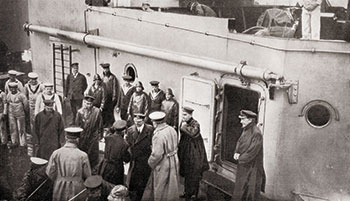
Had there really been a cover-up? Or is there something in the death of a hero which makes a conspiracy seem more believable?
There are plenty of reasons to believe that there is a less dramatic explanation to Lord Kitchener’s death. At the time of the disaster, the Royal Navy high command must already have been overwhelmed trying to make sense of what had happened at Jutland. One can easily imagine the “just what we need!” mood likely to have come upon senior officers at the news that another warship had gone down just off the coast. To be told The Boss was on board must have seemed the last straw.
The war had already continued for far longer than most people had ever anticipated. The Royal Navy’s pummelling at the Battle of Jutland had done nothing for public morale. The catastrophe of the battle of the Somme was merely weeks away. Now this. For years afterwards people could remember where they had been when they heard the news that the man who seemed to embody the war effort had vanished. Stunned crowds stood on the streets, occasionally muttering in low voices. “Now we’ve lost the war. Now we’ve lost the war,” a platoon sergeant was heard wailing as he rocked back and forth in his trench on the western front. A coroner, summing up an inquest in Yorkshire, wrote that “the deceased seems to have become very depressed after learning of the death of Lord Kitchener, and subsequently to have taken his life”.
But it seems to have been something more complicated that stirred Orcadians to raise their memorial. Island folk memory seems to hold it as fact that local people desperate to rescue sailors washed up on their shores had been blocked from doing so, sometimes at the point of a soldier’s bayonet. There are still Orcadians who believe British military headquarters ordered the local lifeboat not to put to sea to attempt a rescue.
Much of this is nonsense. The soldiers with bayonets were probably just trying to secure the shoreline. And what would have been the fate of a wooden lifeboat powered by men at the oars, in seas too heavy for armoured destroyers? Yet the bad smell lingers, even after so many years. Though several notables attended the unveiling of Kitchener’s statue on Horse Guards Parade, not a single senior member of the government came to the dedication of the Orkney memorial.
. . .
The Hampshire lies in about 65 metres of water, a protected war grave. According to two men who dived the wreck before the current ban was introduced, she lies upside down on the seabed and you can swim straight into the cavernous engine rooms (“like Westminster Hall”, says one of them.) The ship’s coal-fired boilers hang from the roof above. The bow is severed from the rest of the ship – “It’s a huge hole, almost a third of the length of the ship,” says John Thornton, a Scapa Flow diver.
Veterans of shipwreck investigations say the first thing that sailors do when abandoning ship is to kick off their sea boots: the seabed at the scene of a disaster is generally littered with shoes or relics of shoes. There were none at the site of the Hampshire – evidence, says Thornton, that “the ship went down very fast indeed”.
Admiralty investigations into the sinking concluded there was no conspiracy. They would, wouldn’t they? And what could be so sensitive that two files in the National Archives remained closed to the public until the end of 2015 and 2025?
. . .
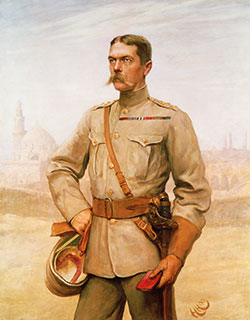
Was it something about his private life? Kitchener was long ago conscripted into the ranks of homosexual history, a gay hero in a less tolerant age. He was, for example, accompanied on his final journey by his aide-de-camp, “Fitz” – Captain Oswald Fitzgerald, of the 18th Bengal Lancers – the latest in a series of handsome younger men on his staff. Fitzgerald had saved his boss from a would-be assassin in Cairo railway station and Kitchener had planned to bequeath his 5,000-acre African estate to him. As it was, “they died in each other’s arms when the HMS Hampshire struck a mine off Orkney in 1916”, the gay activist Peter Tatchell informed Guardian readers 10 years ago. There is not a shred of evidence to support this claim.
It is true that K never married. It is certain that Oswald Fitzgerald also died when the Hampshire went down, and that he had been with Kitchener for nine years, though that hardly adds up to conclusive evidence of anything much. At the time of K’s eminence (and indeed until 1994) homosexual activity in the army was a court martial offence. But – as the part-time prostitution of ordinary soldiers in public parks and the scandals attaching to a few officers periodically demonstrated – homosexuals were, and are, almost certainly as well represented in the army as in any other walk of life. The occasional remark from enemies that Kitchener’s time in Egypt had enhanced his “taste for buggery” proves nothing. Nor does his near-kleptomaniac enthusiasm for fine porcelain, or his passion for orchids, textiles, flower arranging and his pet poodle. Perhaps his insistence that the handsome young men he chose as staff officers move on to other jobs as soon as they married points to what were then known as Uranian tastes, but who knows? Whatever his aesthetic enthusiasms, there is not a jot of proof that Kitchener was what we would understand to be an active homosexual. A man who could endure the privations of imperial campaigning need not necessarily have found abstinence impossible.
There are so many outstanding questions about the great British hero. What could possibly be sufficiently sensitive that one government after another – though more likely some bored functionary low down the food chain – deemed they should stay secret so long after the event? I submitted a Freedom of Information Act request to have them declassified, and discovered that, alas, our heroes succumb to the same plodding fate as the rest of us.
The files are as dull as ditch water. The Inland Revenue wants to get its hands on the proceeds of a sale of a few bits of pottery from the Kitchener estate. There is an undignified wrangle over whether Captain Fitzgerald might have lived a little longer than Kitchener, and therefore could be liable for taxation on the African estates he inherited as he struggled for life in the icy waters off Orkney. There are pages and pages of turgid legalese. But there are no revelations about Kitchener’s private life, no mutters of official anxiety, nothing to suggest a conspiracy of any kind.
. . .
When Lord Kitchener’s effects were returned to England, much of his treasured porcelain arrived from his prewar official residence in Cairo packed in newspaper. The family kept one particular sheet of newsprint which had wrapped part of his dinner service. You can clearly see the circular impression of a plate beneath the headline “HMS Hampshire sinks with all on board”. Was it pure chance that had led an Egyptian servant to choose the front page of the Egyptian Morning News of June 8 1916 to pack away one of the Sirdar’s baubles in the recording of his impermanence? We shall never know, but even at the distance of one hundred years these coincidences can be striking.
The banal is always more likely than the bizarre. With all its strange public displays of grief and crackpot conspiracy theories, public reaction to Kitchener’s disappearance had about it some of the characteristics of the death of Princess Diana. Kitchener – tall, tough, ruthless – was a hero for a different age: who can even name a single serving general today? But once someone has found a place in the popular imagination we do not let them go easily.
Jeremy Paxman is an FT contributing editor. © Jeremy Paxman 2014. The author’s latest book, ‘Great Britain’s Great War’ (Viking, £25) is available now
Photographs: Getty; Alamy
Comments